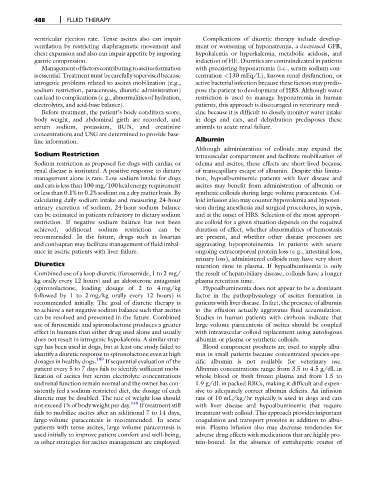Page 500 - Fluid, Electrolyte, and Acid-Base Disorders in Small Animal Practice
P. 500
488 FLUID THERAPY
ventricular ejection rate. Tense ascites also can impair Complications of diuretic therapy include develop-
ventilation by restricting diaphragmatic movement and ment or worsening of hyponatremia, a decreased GFR,
chest expansion and also can impair appetite by imposing hypokalemia or hyperkalemia, metabolic acidosis, and
gastric compression. induction of HE. Diuretics are contraindicated in patients
Managementoffactorscontributingtoascitesformation with preexisting hyponatremia (i.e., serum sodium con-
is essential. Treatment must be carefully supervised because centration <130 mEq/L), known renal dysfunction, or
iatrogenic problems related to ascites mobilization (e.g., active bacterial infection because these factors may predis-
sodium restriction, paracentesis, diuretic administration) pose the patient to development of HRS. Although water
can lead to complications (e.g., abnormalities of hydration, restriction is used to manage hyponatremia in human
electrolytes, and acid-base balance). patients, this approach is discouraged in veterinary medi-
Before treatment, the patient’s body condition score, cine because it is difficult to closely monitor water intake
body weight, and abdominal girth are recorded, and in dogs and cats, and dehydration predisposes these
serum sodium, potassium, BUN, and creatinine animals to acute renal failure.
concentrations and USG are determined to provide base-
line information. Albumin
Although administration of colloids may expand the
Sodium Restriction intravascular compartment and facilitate mobilization of
Sodium restriction as proposed for dogs with cardiac or edema and ascites, these effects are short-lived because
renal disease is instituted. A positive response to dietary of transcapillary escape of albumin. Despite this limita-
management alone is rare. Low sodium intake for dogs tion, hypoalbuminemic patients with liver disease and
and cats is less than 100 mg/100 kcal energy requirement ascites may benefit from administration of albumin or
or less than 0.1% to 0.2% sodium on a dry matter basis. By synthetic colloids during large-volume paracentesis. Col-
calculating daily sodium intake and measuring 24-hour loid infusion also may counter hypovolemia and hypoten-
urinary excretion of sodium, 24-hour sodium balance sion during anesthesia and surgical procedures, in sepsis,
can be estimated in patients refractory to dietary sodium and at the onset of HRS. Selection of the most appropri-
restriction. If negative sodium balance has not been ate colloid for a given situation depends on the required
achieved, additional sodium restriction can be duration of effect, whether abnormalities of hemostasis
recommended. In the future, drugs such as losartan are present, and whether other disease processes are
and conivaptan may facilitate management of fluid imbal- aggravating hypoproteinemia. In patients with severe
ance in ascitic patients with liver failure. ongoing extracorporeal protein loss (e.g., intestinal loss,
urinary loss), administered colloids may have very short
Diuretics retention time in plasma. If hypoalbuminemia is only
Combined use of a loop diuretic (furosemide, 1 to 2 mg/ the result of hepatobiliary disease, colloids have a longer
kg orally every 12 hours) and an aldosterone antagonist plasma retention time.
(spironolactone, loading dosage of 2 to 4 mg/kg Hypoalbuminemia does not appear to be a dominant
followed by 1 to 2 mg/kg orally every 12 hours) is factor in the pathophysiology of ascites formation in
recommended initially. The goal of diuretic therapy is patients with liver disease. In fact, the presence of albumin
to achieve a net negative sodium balance such that ascites in the effusion actually aggravates fluid accumulation.
can be resolved and prevented in the future. Combined Studies in human patients with cirrhosis indicate that
use of furosemide and spironolactone produces a greater large-volume paracentesis of ascites should be coupled
effect in humans than either drug used alone and usually with intravascular colloid replacement using autologous
does not result in iatrogenic hypokalemia. A similar strat- albumin or plasma or synthetic colloids.
egy has been used in dogs, but at least one study failed to Blood component products are used to supply albu-
identify a diuretic response to spironolactone even at high min in small patients because concentrated species-spe-
dosages in healthy dogs. 109 If sequential evaluation of the cific albumin is not available for veterinary use.
patient every 5 to 7 days fails to identify sufficient mobi- Albumin concentrations range from 3.5 to 4.5 g/dL in
lization of ascites but serum electrolyte concentrations whole blood or fresh frozen plasma and from 1.5 to
and renal function remain normal and the owner has con- 1.9 g/dL in packed RBCs, making it difficult and expen-
sistently fed a sodium-restricted diet, the dosage of each sive to adequately correct albumin deficits. An infusion
diuretic may be doubled. The rate of weight loss should rate of 10 mL/kg/hr typically is used in dogs and cats
not exceed 1% of body weight per day. 148 If treatment still with liver disease and hypoalbuminemia that require
fails to mobilize ascites after an additional 7 to 14 days, treatment with colloid. This approach provides important
large-volume paracentesis is recommended. In some coagulation and transport proteins in addition to albu-
patients with tense ascites, large volume paracentesis is min. Plasma infusion also may decrease tendencies for
used initially to improve patient comfort and well-being, adverse drug effects with medications that are highly pro-
as other strategies for ascites management are employed. tein-bound. In the absence of extrahepatic routes of

